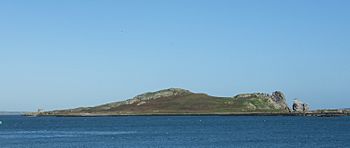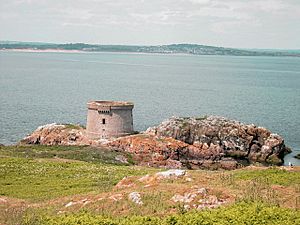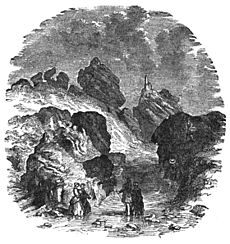Ireland's Eye facts for kids
|
Native name:
Inis Mac Neasáin
|
|
|---|---|

Ireland's Eye from Howth Harbour
|
|
| Geography | |
| Location | Irish Sea |
| Coordinates | 53°24′19″N 6°03′49″W / 53.40528°N 6.06361°W |
| Area | 0.22 km2 (0.085 sq mi) |
| Administration | |
| Province | Leinster |
| County | Dublin |
| Local authority | Fingal County Council |
| Demographics | |
| Population | 0 (2016) |
| Additional information | |
| Owner: Tetrarch Investment Group | |

Ireland's Eye (also known as Irish: Inis Mac Neasáin in Irish) is a small island near Howth Harbour in County Dublin, Ireland. No one lives on the island, but many people visit it by boat. It is located just north of Howth. The island is managed by Fingal County Council. For many years, it was part of the Howth Estate. In 2018, it was sold to a company called Tetrarch.
Contents
Island History and Name
Long ago, in Celtic times, the island was called Eria's Island. Eria was a woman's name. Later, this name was confused with Erin, which comes from Éireann, the Irish name for Ireland. When the Vikings arrived, they used their word ey for island. So, it became known as Erin's Ey, and finally, Ireland's Eye. The island was also once called Inis Faithlenn.
An important old book called the Garland of Howth was mostly written at the island's abbey. This happened sometime between the 8th and 10th centuries.
The island was home to the first church for the village of Howth. It was also an early part of the Howth estate when the St Lawrence family took control of the area.
In 1803, a special tower called a Martello tower was built on the island.
In June 2015, a large part of Ireland's Eye caught fire. This was due to gorse bushes burning.
In October 2018, the family who owned Howth Castle and Ireland's Eye decided to sell them. They sold the island to the Tetrarch investment group. This was a big deal, as the island had been owned by the same family for hundreds of years.
Nature on the Island
Island Shape and Rocks
Ireland's Eye includes the main island, some rocks, and a tiny island called Thulla. The most amazing part is a huge rock called "the Stack." It stands tall at the northeast corner of the island.
The island has one natural spring (a place where water flows out of the ground). This spring is found near where the Martello Tower was built.
Animals and Plants
The island, especially the Stack, is home to many different seabirds. You can see thousands of guillemots, razorbills, fulmars, and gulls here. In the 1980s, Ireland's fifth gannet colony started on the Stack. Now, hundreds of gannet pairs nest there every year. There is also a large group of cormorants on the main island. A few puffins also nest there.
Many Grey seals swim in the sea around the island.
Buildings on Ireland's Eye
The only signs of people living on the island in the past are two old buildings. These are the ruins of a Martello tower and an 8th-century church. The church was called the Church of the Three Sons of Nessan.
The church was used as the main church for Howth for many centuries. But it was hard for people to get there because they had to take a boat for every church service. So, a new church was built in the village of Howth.
The Martello Tower was built in 1803. It was one of three towers built in the Howth area. These towers were built to protect against a possible invasion by Napoleon. The tower's entrance is a window about 5 meters (16 feet) above the ground. People can get in by using a rope that hangs down from the window.
Visiting the Island
Two small boat companies offer trips to Ireland's Eye from Howth Harbour. These trips are available during the summer months. Some visitors also go to the island in their own boats. As of 2020, there are no rules stopping people from visiting the island. There is also no fee to enter. Other boat tours sail around the island but do not stop there.
Ireland's Eye has been a place for rock-climbing for a long time. About 28 climbing paths have been recorded since the 1940s. However, people believe climbers were active on the island even earlier, perhaps in the 1910s. Climbing is not allowed during the seabird nesting season, which is from April to July.
Images for kids
See also
 In Spanish: Inis Mac Neasáin para niños
In Spanish: Inis Mac Neasáin para niños






